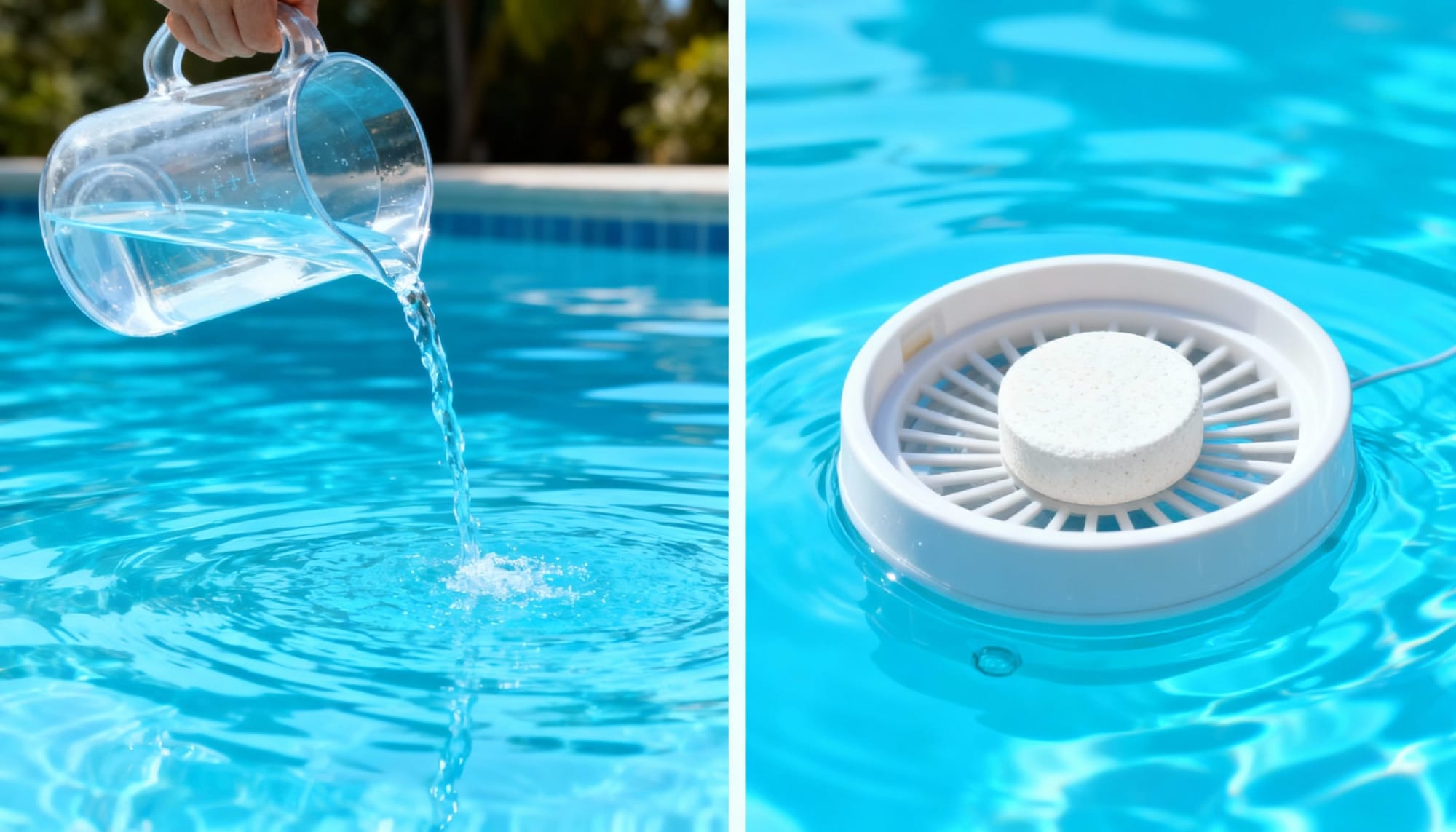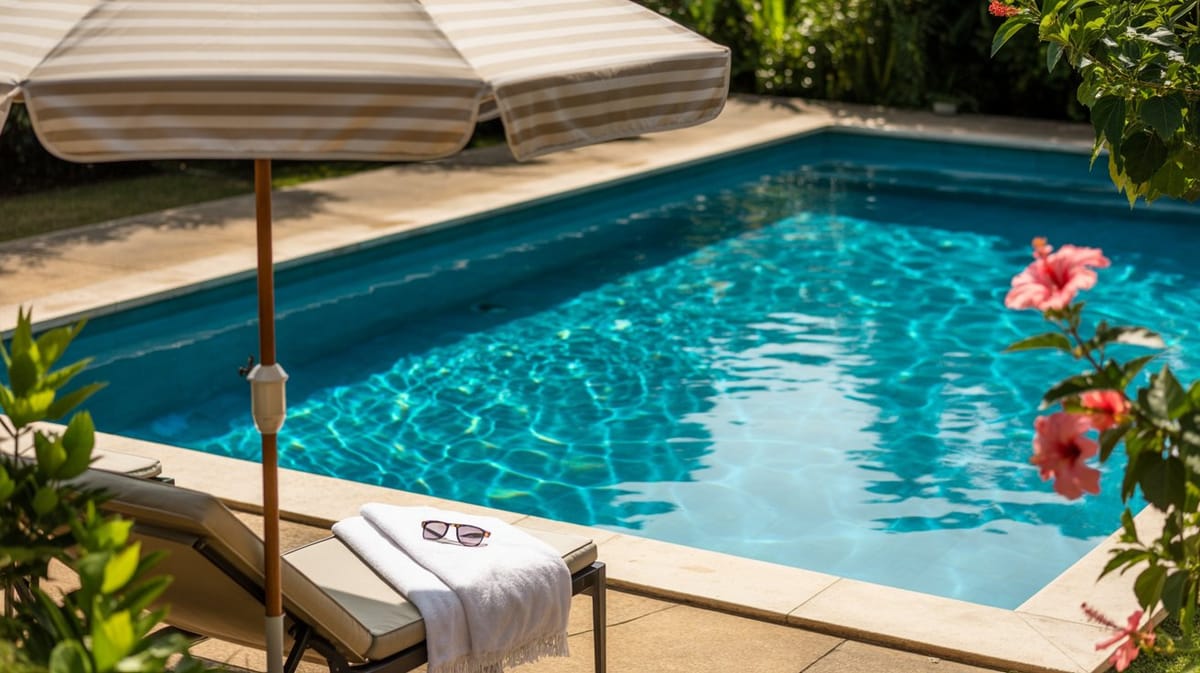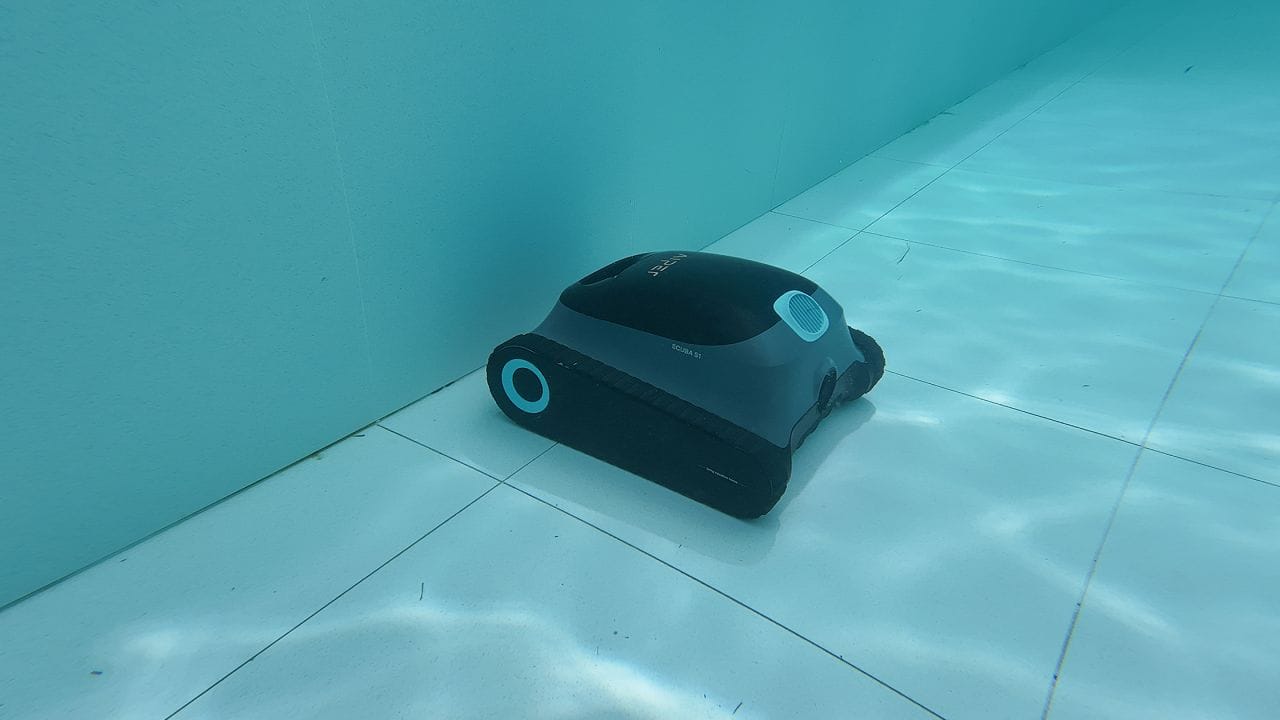Liquid Chlorine vs. Tablets: Which Is the Smart Choice for Your Pool?

Keeping your pool water sparkling clean is the top priority for any pool owner, but navigating the pool chemical aisle can feel overwhelming. The biggest debate often comes down to the core of your sanitation strategy: liquid chlorine vs. tablets. Are you torn between the big jugs of liquid and the convenient buckets of pucks? You're likely weighing the cost, convenience, and the long-term health of your pool.
This ultimate guide will break down the pros and cons of each, backed by guidance from the CDC, to help you make the smartest, most cost-effective decision. Plus, we'll reveal a simple secret that makes whichever chlorine you choose far more powerful.
What Is Liquid Chlorine?
Liquid chlorine, chemically known as sodium hypochlorite, is essentially a stronger, unstabilized version of household bleach. Sold in large gallon jugs, it's a ready-to-use sanitizer that you pour directly into your pool's deep end. Because it's in a liquid state, it disperses and gets to work immediately, making it a powerful tool for both daily chlorination and shocking the pool to eliminate contaminants.
What Are Chlorine Tablets?
Chlorine tablets, also known as pucks, are solid pieces of chlorine that dissolve slowly and are meant to keep things clean for a long time. Trichlor (Trichloro-S-Triazinetrione) is the most prevalent form. It is "stabilized," which means it has cyanuric acid (CYA) in it to keep the chlorine from being burned off by the sun. They are made to be put in a floating dispenser or an automatic in-line chlorinator, where they slowly release chlorine into the water over the course of many days. This is a simple and hands-off way to do it.
The Main Event: Liquid Chlorine vs. Chlorine Tablets Head-to-Head
Liquid chlorine and chlorine tablets both kill germs, but they do it in very different ways. They have quite different effects on your budget, your time, and the chemistry of your pool's water. Let's position them next to each other.
Here's a detailed breakdown that will help you see the differences right away:
|
Feature |
Liquid Chlorine (Sodium Hypochlorite) |
Chlorine Tablets (Trichlor/Cal-Hypo) |
|
Upfront Cost |
Lower per gallon |
Higher per bucket |
|
Ease of Use |
Requires manual, often daily, dosing |
Set-and-forget in a feeder or floater |
|
pH Impact |
High pH (Raises your pool's pH level) |
Low pH (Lowers your pool's pH level) |
|
Stabilizer (CYA) |
Contains no stabilizer |
Contains stabilizer (Primarily Trichlor tablets) |
|
Storage & Shelf Life |
Degrades quickly; sensitive to heat and light |
Very long shelf life, easy and safe to store |
|
Best for Shocking |
Excellent, as it's fast-acting and potent |
Not ideal for shocking (dissolves too slowly) |
Beyond the Basics: What You MUST Know Before Choosing
While the table gives a quick overview, two factors—stabilizer and pH—are critical to your long-term success and should be the deciding factors in your choice.
The Stabilizer (CYA) Trap with Tablets
Trichlor tablets, the most common type, contain Cyanuric Acid (CYA), also known as a stabilizer. CYA is like sunscreen for your chlorine, protecting it from being destroyed by the sun's UV rays. This is a good thing, but it's a double-edged sword.
As you continuously add tablets, the CYA level in your pool builds up. Over time, excessively high CYA levels will "lock" your chlorine, rendering it ineffective at killing germs and algae, even if your test strips show chlorine is present. This is known as chlorine lock.
Liquid Chlorine's pH Challenge
Liquid chlorine has a very high pH (around 13). When you add it to your pool, it will consistently raise the water's pH level. This means you will need to frequently test and add a pH reducer, like muriatic acid or sodium bisulfate, to keep your water balanced. According to the CDC's Model Aquatic Health Code, maintaining a proper pH level (ideally 7.2-7.8) is just as crucial as the chlorine level itself for effective sanitation.

The Secret to Making Your Chlorine More Effective (and Cheaper)
Whether you choose liquid or tablets, your chlorine's main job is to neutralize bacteria and organic contaminants. But what consumes the most chlorine in your pool? Physical debris like leaves, dirt, and algae. Every piece of debris your chlorine has to break down is a waste of its sanitizing power and your money.
Before you even pour that gallon of liquid chlorine or drop in a tablet, the most effective first step is physical removal of debris.
To maximize the efficiency of either liquid chlorine or tablets, removing physical debris before it decays is essential. A robotic pool cleaner can help with this task by scrubbing pool floors, walls, and waterlines and capturing fine debris in its filter. For example, devices such as the Aiper Scuba X1 Pro Max are designed to assist pool owners in maintaining optimal sanitation with less chemical consumption.
A pool regularly cleaned by a pool cleaner requires significantly less chlorine to stay sanitized. This not only cuts your chemical costs but also reduces the chemical load in your water, making your pool healthier and your chosen sanitizer more efficient.

Our Verdict: Which Chlorine Type Wins for You?
The best choice depends entirely on your lifestyle and how hands-on you want to be.
- Choose Liquid Chlorine if... you are a hands-on pool owner who doesn't mind daily testing and dosing. It's great for those on a tight upfront budget and who want precise control over their pool's chemistry without adding CYA.
- Choose Chlorine Tablets if... convenience is your top priority. They are perfect for busy homeowners or those who travel, as they provide consistent chlorination for days at a time. Just be prepared to monitor your CYA levels and partially drain/refill the pool periodically to dilute it.
Ultimately, maintaining a healthy pool relies on both consistent chemical management and effective physical cleaning. Automated pool cleaners can help achieve this by keeping surfaces free of debris, which reduces chlorine consumption and maintains water clarity. For instance, models like the Aiper Scuba X1 Pro Max provide automated scrubbing and filtration, assisting pool owners in maintaining balanced and clean water with less manual effort.
Your Pool Chlorine Questions Answered
Q1: How much liquid chlorine is equal to one chlorine tablet?
A: This depends on the tablet size (typically 3 inches) and the concentration of the liquid chlorine (usually 10-12.5%). As a rough estimate, about half a gallon of 10% liquid chlorine can provide a similar amount of active chlorine as one 8-ounce trichlor tablet over its dissolving period.
Q2: Can I switch between liquid chlorine and tablets?
A: Yes, you can. However, before switching, it's crucial to test your water chemistry, especially your CYA and pH levels, and make adjustments to ensure a smooth transition.
Q3: Is it safe to handle liquid chlorine?
A: Liquid chlorine is caustic. Always wear protective gloves and safety glasses when handling it. Add it to the pool in a well-ventilated area and never mix it directly with other pool chemicals, especially acid.
Q4: Will chlorine tablets damage my pool liner or equipment?
A: Yes, if used improperly. Never place a tablet directly in the pool or in the skimmer basket. The concentrated chlorine can bleach liners and damage pumps or filters. Always use a designated floating dispenser or an automatic chlorinator.
Q5: How can I reduce chlorine use in my pool?
A: Regular physical cleaning is key. Debris and algae consume chlorine, so removing them first helps your sanitizer work more efficiently. Using a robotic pool cleaner, like the Aiper Scuba X1 Pro Max, minimizes debris and reduces your overall chlorine needs.
Q6: What is the easiest way to maintain a pool if I’m busy?
A: Automated solutions are best. A robotic cleaner handles scrubbing and vacuuming daily, while smart monitors like Aiper HydroComm track pH and sanitizer levels in real time, reducing manual testing.
Q7: Which chlorine type is best for small pools?
A: Liquid chlorine is fast-acting and allows precise dosing, which is ideal for smaller volumes. Tablets work too, but be cautious of CYA buildup. Pairing either method with a compact robotic cleaner, such as the Aiper Scuba Mini, keeps water balanced with minimal chemical waste.
Q8: How do I maintain water chemistry in hot Australian summers?
A: High temperatures accelerate chemical consumption and algae growth. Frequent circulation and debris removal help. Tools like the Aiper Surfer 2 solar skimmer prevent surface debris and ensure chlorine efficiency, even during heatwaves.
Q9: Can I automate pool cleaning and chemical management?
A: Yes. Robotic cleaners remove physical debris automatically, while smart monitors like the Aiper HydroComm track chemical levels. This combination lets you maintain ideal water quality with minimal effort.
References:
- Centers for Disease Control and Prevention (CDC). (2024). The Model Aquatic Health Code (MAHC).


